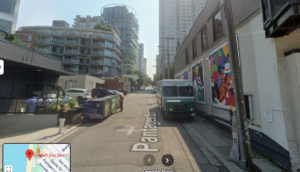Beach Ave, Vancouver, BC V6C 3C1 Canada
October 23, 2025 By: Grace Fang
Location: 49.28664005876915, -123.14328455431782

Local Environmental History OF Beach Avenue, Vancouver, BC
Introduction
I currently live on Beach Avenue in downtown Vancouver, Canada, in English Bay. When I moved here with my family a few years ago, I was immediately captivated by the city and nature, and when I opened the window in my room, I could see the beach of English Bay and a three-minute walk to the park. Before this, I had not studied the history of this place, but after consulting the information in detail, I found that Beach Avenue is the epitome of Vancouver’s urbanization and ecological conservation, from the fishing and hunting grounds of the Aboriginal people to the industrialization of gas works and railroads.
1.Indigenous Land and Pre-Contact Use
Before European colonization, the area was part of the traditional territories of the Musqueam, Squamish and Tsleil-Waututh Nations [1]. In spring and summer, the indigenous people collect Manila clams and oysters in the intertidal zone on the west side of Beach Ave, and use fishbone tools to dig up sand-dwelling shellfish; In the fall, bridge fishing is built at the mouth of False Creek to catch coho salmon. These Aboriginal people have established temporary camps along what is now Beach Avenue for generations. These camps were used for seasonal migration and ceremonial activities [2]. Due to the lack of written documentation, the specific location of seasonal campsites on Beach Ave is yet to be confirmed.
In terms of forest management, the Squamish implement controlled burning in the taiga forest of Stanley Park, removing understory shrubs to promote the growth of ferns that the herd loves to eat, while maintaining a healthy community of Douglas firs. This model allowed the area to maintain a complete ecological chain of forests, wetlands, and coasts until the 19th century.
2.Early Settlement and Resource Extraction
In the mid-19th century, gas production and sawmilling became major industries in the False Creek area. Beach Avenue was originally a beach and tidal flats of the bay, but was land reclamation in the 1890s–1910s to support the railroad and gas works infrastructure [4].
The ecological changes during this period were significant: first, coastal wetlands were removed, which led to the disappearance of fish spawning grounds; Immediately afterwards, the original salt marshes were converted into ports and roads; At the same time, a large number of exotic plants such as Scotch broom and English ivy were brought into the horticulture and greening project [5].
3.Urban Development and Ecological Transformation
After the opening of the Canadian Pacific Railway in 1887, Vancouver expanded rapidly from a town of 1,000 people. In the early 20th century, Beach Avenue was formally incorporated into Vancouver’s urban planning, and in the 1910–1920s, the Stanley Park seawall and the Beach Avenue promenade were built [6]. The opening of the Granville Street Bridge in 1954 marked a turning point in Beach Ave’s ecological landscape. The construction of piers at the city’s north-south transportation hub has destroyed underwater reef habitat, blocking the otherwise common salmon migration route. In 2019, landmarks such as Vancouver House were inaugurated on the bridgeside, and although twisted structures were used to reduce shading, high-density development reduced green space coverage along Beach Ave from 40% in the 1950s to 18% today.
With urban expansion and real estate development, the original coastline has been renovated into a continuous embankment, and the vegetation has been replaced by ornamental greenery. Since the 2000s, the city government has launched the Greenest City Action Plan to reduce urban runoff and waste through stormwater management systems and public composting facilities [7]. Currently, there are several electric vehicle charging stations, green rooftop buildings, and community gardens near Beach Avenue, reflecting a new phase of urban sustainability [8].
4.Wildlife and Stewardship Actions
Ecosystem disturbances also come from biological invasions and climate change. The tropical organism Pyrosome, which appeared in Vancouver waters in 2017, did not form a large cluster near Beach Ave, but it reflects a warming trend in the ocean. Extreme heat in 2021 led to a 37% shellfish mortality rate in the Gulf of England.
Although Beach Avenue is highly urbanized today, some wildlife such as gulls, cormorants, harbour seals and winter-migrating waterbirds can still be observed [9]. To restore coastal ecology, the False Creek Watershed Society works with the city to monitor invasive plants and restore native vegetation [10]. What is more meaningful is the restoration project with the participation of indigenous peoples. In 2023, Squamish Nation partnered with the city to restore a small tide pool on the western section of Beach Ave, recreating traditional shellfish habitat.
Works Cited
City of Vancouver – Indigenous Relations and Reconciliation: Green Vancouver | City of Vancouver
UBC Indigenous Foundations – Coast Salish Territories: Search results for “Coast Salish Territories”
City of Vancouver Archives – False Creek Industrial Development: Search Archives – City of Vancouver Archives
City of Vancouver – English Bay Beach History: https://vancouver.ca/parks-recreation-culture/english-bay-beach.aspx
City of Vancouver – Greenest City Action Plan: Greenest City Action Plan | City of Vancouver
Vancouver Engineering Dept. – Green Infrastructure: Green rainwater infrastructure | City of Vancouver